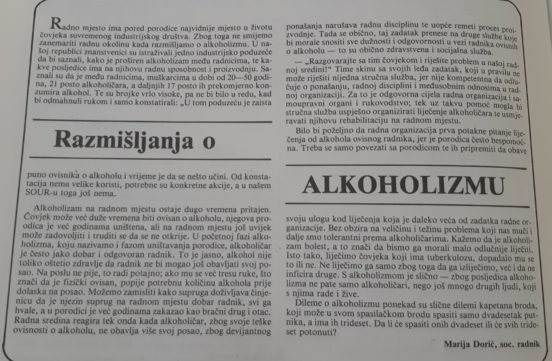The introduction of market socialism and Yugoslavia’s opening up to the world in the 1960s had a positive impact on Pula. Foreign trade became freer, while the establishment of the Non-Aligned Movement brought an additional impetus to the economy through cooperation with the Third World. The Uljanik shipyard was Istria’s strongest company. It employed a large number of workers, many of whom came from other federal units within Yugoslavia. Collective memory offers us a set of memories that support the claim that Uljanik was a success both in international markets and in the Yugoslav labour market.[1]
Alcohol addiction was recorded among Uljanik workers and was reported in the 1980s in the Uljanik newsletter, which was a print media form used to inform external and internal audience about developments within the working collective. The analysed seven-year period (1982–1988) leads us to conclude that safety at work was a valued issue. Even though it had no special section in the newsletter, alcoholism – as an addiction and disease – was increasingly being paid attention to, while the articles’ aim was to inform readers about alcoholism’s harmful effects and to provide advice and assistance to those in need.
The shipbuilding industry does not tolerate intoxicated people because there is a constant and high risk of serious injuries and accidents at work. Alcoholism economically damages the work community due to the frequent sick leave taken by addicted workers, their poor productivity and premature loss of working ability.[2] If a regular person takes on average 30 days of sick leave, the alcoholic takes 60. However, not all alcoholics as a rule often take sick leave. There are those who work normally and who cannot be said to be sick.[3] The Uljanik newsletter from the 1980s provides a great deal of basic information on the problem of alcohol consumption in the shipyard and addresses alcoholism, which was introduced as an illness in the 1951 International Classification of Diseases.[4] Prolonged and excessive alcohol consumption causes health (e.g. severe organ damage, often a direct cause of death) and social difficulties. Alcoholics are not able to make their own decisions. Their marriages are unstable and their families tend to fall apart, while children show poor progress at school and become alienated from their surroundings. Family quarrels are frequent and sleeplessness is a widespread phenomenon leading to constant nervousness. In many cases, family members are forced to seek help. Alcoholics are often considered irresponsible and it has been claimed that alcoholism is a moral problem.[5] Even though there are many high functioning alcoholics who think critically, some do not seek medical help given the fact that their critical reasoning is greatly diminished, but instead come to the doctor for other symptoms caused by the disease itself. Few alcoholics will admit to being sick. This behaviour is the result of a moralistic approach to the disease, and because society treats alcoholics as people of the lowest social rank.[6]
There are two types of alcohol addiction: psychological and physical addiction. Psychological addiction is characterized by the fact that as soon as alcohol triggers one, they lose control and continue to drink until they are severely intoxicated. This form of addiction means that the person is unable to cope with life’s problems without alcohol. Physical addiction means that one’s body cannot do without alcohol. The person drinks on a daily basis and often has to drink a large amount of alcohol immediately in the morning. As soon as the blood alcohol concentration decreases, disturbances such as restlessness, irritability and nausea occur. A physically addicted person usually does not enter a state of serious intoxication, but is never completely sober. Physical addiction is also characterized by amnesia, loss of control, decreased tolerance and behavioural disorders. The person’s health, social and financial degradation is also devastating to their work community. Alcoholism shortens one’s lifespan by 15 to 20 years and one’s working life by about ten years. Such people generally live to the age of 50 or 55.[7] The disease can remain hidden in the workplace for a long time because the person is able to continue to fulfil their employer’s demands and remain undiscovered. An alcoholic is often a good and responsible worker in the initial stage of the disease. They drink secretly, and if their hands shake (a symptom of physical addiction), they will drink the required amount of alcohol before coming to work to prevent this.[8]

Uljanik 1982-1986
Alcoholism most greatly affects people between the ages of 30 and 40, which is a period in which one has significant work and life experience as well as high productivity. An alcoholic has a sense of false security and boldness. They experience frequent injuries, tend to be late for work, and over time, conflicts in workplace relationships occur. Comprehensive social action is needed to combat alcoholism, to make people aware that it is a serious disease, and to prevent the occurrence of individual cases, as well as allowing those who have undergone treatment to integrate normally into work and other communities.[9] Courses, lectures in schools, local communities and work organizations help to achieve that, but it takes a lot of patience and perseverance to change one’s understanding of alcoholism.[10]
There were about 3,000 alcoholics in Pula in 1982. If we include family members, it is clear that the number of people at risk was high. Back then, Uljanik had over 200 registered addicts. Taking into account the number of alcoholics in Pula and knowing the circumstances in the shipyard, it can be claimed that the number of addicts was significantly higher.[11] Two years later, in 1984, there were 700 registered addicts in Uljanik, while in 1986, out of 6,500 Uljanik workers, about 1,000 of them suffered from alcoholism and approximately the same number drank excessively.[12]
The work community reacted only when the worker was no longer doing their job due to their heavy addiction, undermining work discipline and undermining the production process. Health and social services could get involved, but their viewpoint was that straightforwardly talking to the person would solve the problem. The work community needed to be the first to raise the issue of treatment. They would speak with the family and prepare them to do their part.[13]
It was necessary to start work on the early detection and prevention of alcoholism as well as the treatment of addicts. Clubs of alcoholics in treatment are professional therapy organizations in which addicts are treated and trained to permanently abstain, besides being prepared for their quality re-inclusion in their work and social communities. On 19 October 1982, the Uljanik Club of Alcoholics in Treatment was established. Alcoholics in treatment and those who wanted to be treated could join it (provided they did not consume alcohol from the moment they joined the club), as could their family members and all those who wanted to contribute to the club’s work and success. Disciplinary policy required that alcoholics found in an intoxicated state in the workplace be referred for treatment or, if they refused, be sanctioned in accordance with the Labour Relations Regulations. Coming to work in a tipsy or intoxicated state, drinking alcoholic beverages at work and not reporting such workers – the Labour Relations Regulations considered all these to be a serious violation of obligations. The need to develop a climate of appreciation and support for the club’s activities and all activities combating alcoholism and preventing the import, distribution and consumption of alcoholic beverages in the workplace were emphasized. The purpose was to support the workers and members of the club, while addicts were to be directed to therapists and the club.[14] Attendance was strictly noted. If a person was unable to attend, they had to let others know in advance and give a valid excuse. Club members were encouraged to discuss their individual fates, read and comment on texts about alcoholism, as well as constantly support one another beyond the one-and-a-half hour sessions, even when individuals fell short and no longer attended the meetings. The club’s statute stipulated that a member who once again became a consumer of alcohol should be visited four times before being written off.[15]
The Uljanik Club of Alcoholics in Treatment introduced a novelty in 1986. A club member, their family and the therapy team had to sign an agreement (a therapeutic pact) on treatment. The incentive was designed to give more weight to club therapy after hospital treatment. Treated alcoholics were obliged to no longer drink and regularly attend therapy sessions for at least five years. Family members and the work community made concerted efforts to ensure that the treated alcoholic persisted in their decision not to drink anymore and to integrate as successfully as possible into their work and family lives.[16]
At the end of 1986, the club gained its own space in a solitary hotel where two groups with a doctor and social worker at the helm met once a week. Several wives of alcoholics came to the club meetings, which was a great help, while the managers and executives learned the correct behavioural patterns and hence to immediately report possible crises and the problems of alcoholics in treatment. The newsletter gives us the example of a manager who, before handing out tasks each morning, monitored if his employees – club members – had taken their medication. At the beginning of 1988, the club had 32 members who were persistent in abstaining and carrying out the agreements outlined in the therapeutic pact. Previously, members of the club also included those who did not drink for a month or two during which they came to the club meetings, but who then once again indulged in consumption and stopped coming, which indicated their indecision and frivolity.[17]
We did a lot of overtime for a while during which I did not come to the therapeutic community meetings. Some people at work told me that it is better to work overtime and thus earn more than to be present at the meetings. At work I did not drink alcohol at all. Others could do so, but not me. Arriving back home tired I would relax with a drink, maybe because my mother, who is a chronic alcoholic, lives with us, so there were always alcoholic beverages there. After treatment on the island of Rab, I started drinking again. Over time, I felt more and more anguish and pain. A damaged liver, restless sleep. I often took sick leave. But then my wife visited a social worker and told her it could not go on like that any longer. That opened my eyes. I visited the social worker when she summoned me, and she criticized me so much that I started crying. I decided to start undergoing treatment. And now I will start attending the meetings again. I realized that if I had continued, my family and I would have collapsed, and that I would have had unpleasant consequences at work.[18]
It is more efficient, useful and reasonable to treat patients with psychotherapy including family-and work-community involvement than to send addicts to institutions where they are separated from everything. In the first half of 1984, Uljanik had a health clinic that employed six teams of doctors and had good treatment conditions. Two doctors successfully passed specialist training in treating addictions, while a third one was interested in this topic.[19] Club members were encouraged to have open and specific conversations about everyday situations. Meetings were considered successful only if everyone was active in such a way that there was no hesitation to talk.[20]
After treatment, an alcoholic struggles to carry on with life for almost a year. They are happy and proud that they are no longer addicted, but if others do not show understanding and decline to help them, they can indulge in alcoholism again, which is then even more severe. It is important to fill the time, the empty and long hours, that came into existence out of the five-year or fifteen-year drinking habit and that now needs to be replaced. One has to find the strength to persevere in the treatment, win over self-doubt, and escape from the moment when it is not possible to return anymore and when treatment is no longer possible.[21]
Large amounts of alcohol were secretly brought inside Uljanik. It was difficult to catch those who sold it. Everyone pretended that no one saw them and that no one knew about them. In many cases people silently watched addicts get drunk, while the security service was summoned only in cases when an intoxicated worker had to be taken out. This meant that little was known about alcoholism as a disease. After treatment the person had to be given easier jobs, even over a longer period of time. Some workers felt that consumption by those who had self-control and who were not harmed by alcohol could not be prohibited. However, most people believed that any intake of alcohol and its sale had to be banned.[22]
The number of alcohol addicts is increasing rapidly mostly in industrialized countries. Many people put this disease in third place, by number of cases, just behind heart and vein diseases, as well as nerve and mental diseases.[23]
A young person may become an alcoholic because they are pressured by feelings of insecurity due to certain circumstances in society or the family. This must be discussed as early as in elementary school, and others should know the right way to treat those who have the disease.[24] Alcohol has been used since time immemorial and it is impossible to prevent alcoholism by prohibiting its consumption, but it is of the utmost importance to prevent the onset of addiction and its consequences. Alcoholics and those on the way to becoming sick should be helped sooner, without waiting for the moment when they have to go for treatment. It is not easy to say “I am an alcoholic” and it takes a lot of will and perseverance to suppress the urge to drink alcohol. The motive is strong – children need their father, the wife wants her husband, while the work community wants an exemplary worker. Telling an intoxicated worker they cannot work anymore and initiating a disciplinary procedure is a good deed. It is likely that the person will start undergoing treatment.[25]
Alcoholism
as a problem and disease cannot be wiped out. Difficult everyday lives and
stressful work environments encourage people to find relief in alcohol, which
is always available as a distraction and will seemingly relax the worker, but
the consumption level will often be constant or increase. Although alcohol
consumption continued in Uljanik, success was achieved in spreading awareness
of its harmfulness.
David Žufić earned his MA degree in history at the Juraj Dobrila University of Pula in 2019 when he defended his thesis on the city of Pula at the turn of the 1980s and 1990s.
[1] Dukovski, Darko. Povijest Pule: deterministički kaos i jahači apokalipse, Pula: Istarski ogranak Društva hrvatskih književnika, 2011, 261, 273.
[2] “Odlučnije u suzbijanju alkoholizma,” Uljanik, 22–23, 20.11.1982, 28.
[3] “O alkoholizmu s Rencom Blažićem,” Uljanik, 66, 6.6.1986, 24.
[4] Ibid.
[5] “Odlučnije u suzbijanju alkoholizma,” Uljanik, 22-23, 20.11.1982, 28; “Treba shvatiti da je to bolest koju treba liječiti,” Uljanik, 38, 5.2.1984, 21.
[6] “O alkoholizmu s Rencom Blažićem,” Uljanik, 66, 6.6.1986, 24.
[7] “Odlučnije u suzbijanju alkoholizma,” Uljanik, 22-23, 20.11.1982, 28.
[8] “Razmišljanja o alkoholizmu,” Uljanik, 52, 1.4.1985, 22.
[9] “Treba shvatiti da je to bolest koju treba liječiti,” Uljanik, 38, 5.2.1984, 21.
[10] “Alkoholizam – bolest koja se ne liječi samo u zdravstvenim ustanovama,” Uljanik, 47, 12.11.1984, 20.
[11] “Odlučnije u suzbijanju alkoholizma,” Uljanik, 22-23, 20.11.1982, 28.
[12] “Treba shvatiti da je to bolest koju treba liječiti,” Uljanik, 38, 5.2.1984, 21; “O alkoholizmu s Rencom Blažićem,” Uljanik, 66, 6.6.1986, 24.
[13] “Razmišljanja o alkoholizmu,” Uljanik, 52, 1.4.1985, 22.
[14] “Odlučnije u suzbijanju alkoholizma,” Uljanik, 22–23, 20.11.1982, 28.
[15] “Posjet Klubu liječenih alkoholičara,” Uljanik, 35, 4.11.1983, 24.
[16] “Dogovorom do uspješnijeg liječenja alkoholičara,” Uljanik, 76, 1.4.1987, 22.
[17] “Savjesnije i ozbiljnije,” Uljanik, 85, 1.1.1988, 24.
[18] “Posjet Klubu liječenih alkoholičara,” Uljanik, 35, 4.11.1983, 24.
[19] “Alkoholizam – bolest koja se ne liječi samo u zdravstvenim ustanovama,” Uljanik, 47, 12.11.1984, 20.
[20] “Klub liječenih alkoholičara,” Uljanik, 61, 1.1.1986, 27.
[21] “Posjet Klubu liječenih alkoholičara,” Uljanik, 35, 4.11.1983, 24.
[22] “Posjet Klubu liječenih alkoholičara,” Uljanik, 35, 4.11.1983, 24.
[23] “Odlučnije u suzbijanju alkoholizma,” Uljanik, 22-23, 20.11.1982, 28.
[24] “O alkoholizmu s Rencom Blažićem, doktorom,” Uljanik, 66, 6.6.1986, 24.
[25] “Prijeko potrebno obrazovanje,” Uljanik, 64, 1.4.1986, 22.
Source
Uljanik, 1982–1988.
Literature
Dukovski, Darko. Povijest Pule: deterministički kaos i jahači apokalipse, Pula: Istarski ogranak Društva hrvatskih književnika, 2011.

